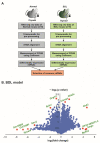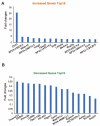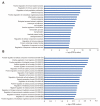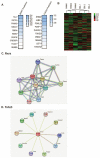Transcriptome Profile of Thyroid Glands in Bile Duct Ligation Mouse Model
- PMID: 35897811
- PMCID: PMC9332885
- DOI: 10.3390/ijms23158244
Transcriptome Profile of Thyroid Glands in Bile Duct Ligation Mouse Model
Abstract
Thyroid hormone (TH) contributes to multiple cellular mechanisms in the liver, muscle cells, adipose tissue, and brain, etc. In particular, the liver is an important organ in TH metabolism for the conversion of thyronine (T4) into triiodothyronine (T3) by the deiodinase enzyme. TH levels were significantly decreased and thyroid-stimulating hormone (TSH) levels were significantly increased in patients with liver failure compared with normal subjects. Among liver failure diseases, hepatic encephalopathy (HE) deserves more attention because liver damage and neuropathologies occur simultaneously. Although there is numerous evidence of TH dysregulation in the HE model, specific mechanisms and genetic features of the thyroid glands in the HE model are not fully understood. Here, we investigated the significantly different genes in the thyroid glands of a bile duct ligation (BDL) mouse model as the HE model, compared to the thyroid glands of the control mouse using RNA sequencing. We also confirmed the alteration in mRNA levels of thyroid gland function-related genes in the BDL mouse model. Furthermore, we evaluated the increased level of free T4 and TSH in the BDL mouse blood. Thus, we emphasize the potential roles of TH in liver metabolism and suggest that thyroid dysfunction-related genes in the HE model should be highlighted for finding the appropriate solution for an impaired thyroid system in HE.
Keywords: RNA sequencing; bile duct ligation (BDL) model; hepatic encephalopathy (HE); thyroid gland; thyroid hormone (TH).
Conflict of interest statement
The authors declare no conflict of interest.
Figures





Similar articles
-
A mouse model of hepatic encephalopathy: bile duct ligation induces brain ammonia overload, glial cell activation and neuroinflammation.Sci Rep. 2022 Oct 20;12(1):17558. doi: 10.1038/s41598-022-22423-6. Sci Rep. 2022. PMID: 36266427 Free PMC article.
-
Systemic inflammation without gliosis mediates cognitive deficits through impaired BDNF expression in bile duct ligation model of hepatic encephalopathy.Brain Behav Immun. 2018 May;70:214-232. doi: 10.1016/j.bbi.2018.03.002. Epub 2018 Mar 5. Brain Behav Immun. 2018. PMID: 29518527
-
Aging Is Associated with Low Thyroid State and Organ-Specific Sensitivity to Thyroxine.Thyroid. 2019 Dec;29(12):1723-1733. doi: 10.1089/thy.2018.0377. Epub 2019 Sep 26. Thyroid. 2019. PMID: 31441387
-
Thyroid hormone regulation of metabolism.Physiol Rev. 2014 Apr;94(2):355-82. doi: 10.1152/physrev.00030.2013. Physiol Rev. 2014. PMID: 24692351 Free PMC article. Review.
-
The hypothalamus-pituitary-thyroid axis in critical illness.Neth J Med. 2009 Nov;67(10):332-40. Neth J Med. 2009. PMID: 19915227 Review.
Cited by
-
Recent advances in gut microbiota and thyroid disease: pathogenesis and therapeutics in autoimmune, neoplastic, and nodular conditions.Front Cell Infect Microbiol. 2024 Dec 24;14:1465928. doi: 10.3389/fcimb.2024.1465928. eCollection 2024. Front Cell Infect Microbiol. 2024. PMID: 39776440 Free PMC article. Review.
References
MeSH terms
Substances
Grants and funding
LinkOut - more resources
Full Text Sources

